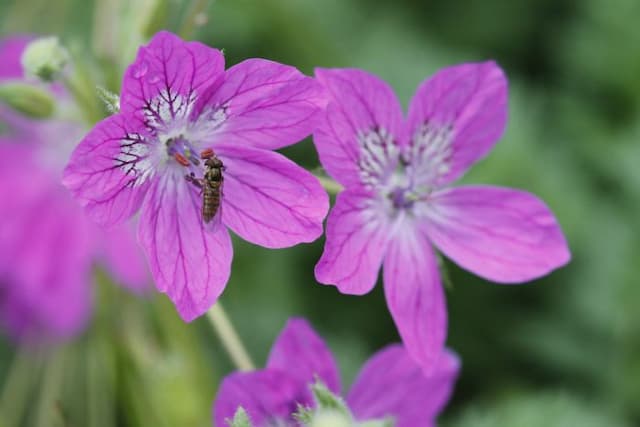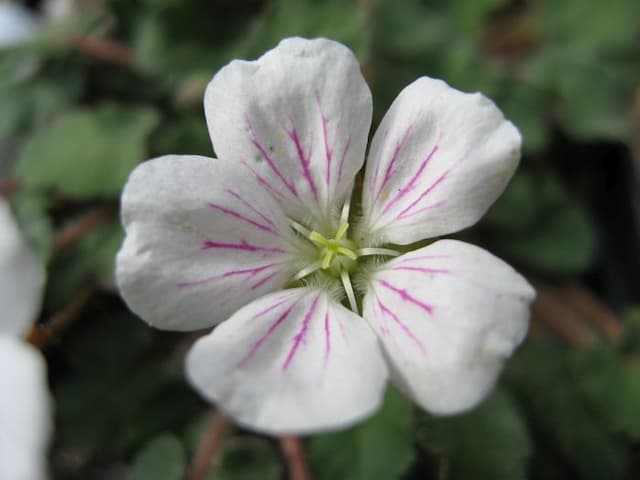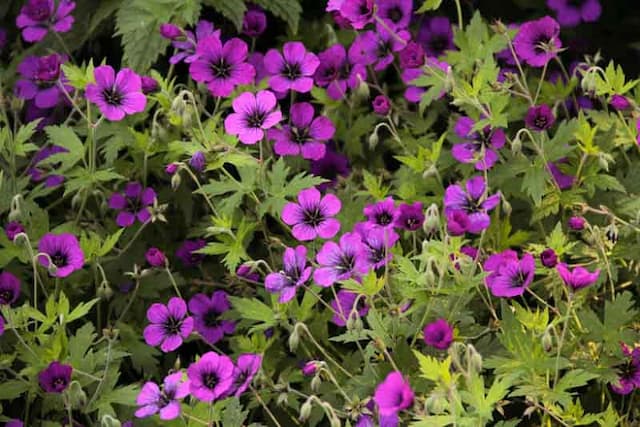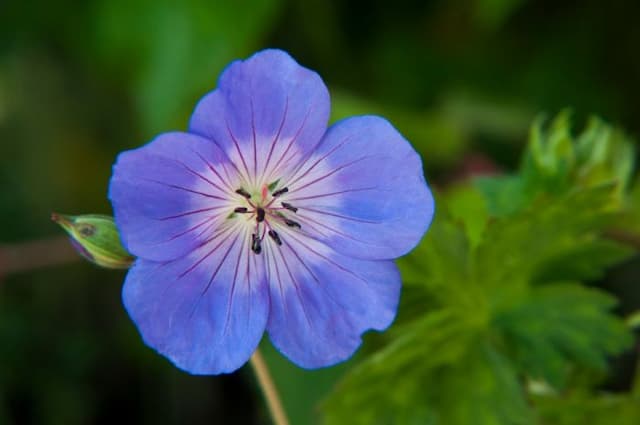Geranium Pelargonium 'The Boar' (Fr)

ABOUT
Pelargonium 'The Boar' is a captivating plant known for its ornamental qualities, commonly referred to as a geranium. Its leaves are deeply lobed and often bear a zonal pattern with darker markings. These patterns give the foliage a distinctive and attractive appearance, adding texture and contrast to the green background of the leaves. The flowers of Pelargonium 'The Boar' are particularly striking, usually presented in clusters atop long stems, which make them stand out against the foliage below. Each flower is composed of individual petals that can come in a range of colors, often in shades of pink, red, or white, adding a splash of color that can be quite eye-catching in any garden setting. The blooms may have distinct veining or may be a solid color, and they typically have a rounded shape with slightly ruffled edges, giving them a delicate and slightly romantic appearance. Overall, the appearance of Pelargonium 'The Boar' is lush and vibrant, with a bushy and full growth habit that makes it a popular choice among gardeners and plant enthusiasts. The plant's aesthetic appeal is enhanced by its bright flowers and patterned leaves, making it an excellent addition to both indoor and outdoor plant collections.
About this plant
 Names
NamesFamily
Geraniaceae.
Synonyms
The Boar Geranium, Wild Boar Pelargonium.
Common names
Pelargonium 'The Boar'
 Toxicity
ToxicityTo humans
Geraniums, which Pelargonium 'The Boar' is commonly referred to as, are not considered highly toxic to humans. However, ingestion of plant parts can potentially cause minor symptoms such as nausea, vomiting, or diarrhea. It is advisable to avoid eating any part of the geranium plant due to its potential for mild gastrointestinal upset.
To pets
Geraniums are known to be toxic to pets, particularly to dogs and cats. If a pet ingests any part of a geranium, symptoms may include vomiting, anorexia, depression, and dermatitis. The most concerning component is geraniol, along with linalool, which can lead to more severe symptoms if consumed in large quantities. It's best to keep geraniums out of reach of pets to prevent any accidental ingestion and potential toxicity.
 Characteristics
CharacteristicsLife cycle
Perennials
Foliage type
Evergreen
Color of leaves
Varies
Flower color
Varies
Height
2 feet (60 cm)
Spread
2 feet (60 cm)
Plant type
Herb
Hardiness zones
Varies
Native area
South Africa
Benefits
 General Benefits
General Benefits- Aesthetic Appeal: Pelargonium provides bright and colorful flowers that enhance the beauty of gardens and landscapes.
- Low Maintenance: It is easy to grow and requires minimal care, making it ideal for novice gardeners or those with limited time.
- Drought Tolerance: Once established, Pelargoniums are quite tolerant to drought, which makes them suitable for xeriscaping or water-conserving gardens.
- Versatility: It can be grown in a variety of settings, including pots, containers, hanging baskets, and beds, offering flexibility in design and space utilization.
- Long Blooming Period: Pelargonium often has a prolonged blooming season, providing color and interest throughout the growing months.
- Attracts Pollinators: The flowers of the Pelargonium can attract beneficial insects such as bees and butterflies, aiding in the pollination of plants in the garden.
- Ease of Propagation: Pelargonium can be easily propagated from cuttings, allowing gardeners to quickly expand their plantings or share with others.
 Medical Properties
Medical PropertiesThis plant is not used for medical purposes.
 Air-purifying Qualities
Air-purifying QualitiesThis plant is not specifically known for air purifying qualities.
 Other Uses
Other Uses- Pelargoniums can be used in potpourri mixes for their scented leaves, which provide a pleasant fragrance when dried and mixed with other aromatic plants.
- The leaves of some pelargoniums can be infused into oils or vinegars to impart a subtle flavor, ideal for culinary experimentation in dressings and marinades.
- When pressed, pelargonium leaves can be used to create botanical prints, which are often used in crafts or to decorate homemade cards and bookmarks.
- Their vibrant flowers can also be used as a natural dye source, providing shades of pink and purple for coloring fabrics and yarns.
- Pelargoniums may serve as companion plants in vegetable gardens, where their strong scent is said to help repel certain pests from more vulnerable crops.
- Some gardeners use dried pelargonium leaves to create a natural insect repellent sachet to ward off moths and other insects from closets and drawers.
- Their leaves and flowers can be floated in water bowls as a decorative element for garden parties or outdoor events.
- When grown in containers, pelargoniums can be used to create a living privacy screen on balconies or patios, providing both beauty and seclusion.
- Creative crafters may use the sturdy stems of pelargoniums to construct miniature plant stakes or supports for other, more delicate plants in a garden setting.
- For photographers and artists, the unique form and color of pelargoniums can provide inspiration and serve as a subject for artwork, from still life compositions to botanical illustrations.
Interesting Facts
 Feng Shui
Feng ShuiThe plant commonly known as Geranium is not used in Feng Shui practice.
 Zodiac Sign Compitability
Zodiac Sign CompitabilityThe Geranium is not used in astrology practice.
 Plant Symbolism
Plant Symbolism- Resilience: The robust character of the wild boar, represented by the cultivar name 'The Boar', symbolizes hardiness and the ability to withstand challenging conditions.
- Protection: The wild boar is known for its protective nature, which reflects in the plant as a symbol of safeguarding one's space and well-being.
- Prosperity: In some cultures, the boar is seen as a symbol of wealth and prosperity, which can be attributed to this plant as well, suggesting growth and abundance.
 Water
WaterGeraniums, commonly referred to in this case as Pelargonium 'The Boar', require moderate watering. It is advised to water these plants when the top inch of soil feels dry to the touch. Typically, watering once a week is sufficient, but this may vary depending on the climate and indoor conditions. When watering, aim to provide enough water to soak the soil without leaving the plant waterlogged, which could equate to around two to three gallons per month for an outdoor garden geranium, depending on the size and environmental conditions.
 Light
LightGeraniums thrive best in bright, indirect light. Placing them near a south or west-facing window with some light shading is ideal, ensuring they receive ample light without being exposed to the harsh midday sun. Do not place them in deep shade, as this can hinder flower development and lead to leggy growth.
 Temperature
TemperatureGeraniums perform optimally in temperatures between 65°F and 75°F during the day and no lower than 50°F at night. They can survive in temperatures as high as 80°F but should be protected from frost and freezing conditions.
 Pruning
PruningPruning geraniums encourages bushier growth and more blooms. Deadhead spent flowers regularly to promote new growth and cut back leggy stems in spring or summer. Pruning is ideally done after the last frost when the plant resumes active growth, and throughout the blooming season as necessary.
 Cleaning
CleaningAs needed
 Soil
SoilThe best soil mix for geraniums (Pelargonium 'The Boar') is one that is well-draining and fertile with even moisture retention. A mixture of peat, perlite, and potting soil in equal parts works well. Geraniums prefer a soil pH between 6.0 to 7.5. Adjustments to the soil mix can be made with lime or sulfur to achieve the desired pH.
 Repotting
RepottingGeraniums (Pelargonium 'The Boar') should be repotted every one to two years, or when they outgrow their current containers. The best time for repotting is in the early spring before the onset of the growing season, which will give the plants time to establish in their new pots.
 Humidity & Misting
Humidity & MistingGeraniums (Pelargonium 'The Boar') are tolerant of a wide range of humidity conditions and do not require high humidity. They perform well in average household humidity levels. To ensure good growth, keep the plants in an environment where the humidity is neither extremely low nor excessively high.
 Suitable locations
Suitable locationsIndoor
Place geraniums in bright, indirect light and avoid overwatering.
Outdoor
Geraniums need sun but afternoon shade in hot climates.
Hardiness zone
9-12 USDA
 Life cycle
Life cyclePelargonium 'The Boar', commonly known as Geranium 'The Boar', begins its life as a seed which germinates in warm, moist soil. Upon germination, the plant develops a rosette of leaves and a root system that anchors it to the ground. As it matures, the geranium grows upright stems and produces more leaves, which are often fragrant and velvety. The next stage is flowering, where the plant produces clusters of colorful blooms that can attract pollinators. After pollination, the flowers will develop into seed capsules if conditions are favorable, completing the reproductive cycle. As a perennial, Geranium 'The Boar' may enter a period of dormancy during colder months, only to regrow from its rootstock when the conditions become suitable again.
 Propogation
PropogationPropogation time
Spring-Early Summer
Propogation: For Pelargonium commonly known as geranium, specifically the 'The Boar' variety, the most popular method of propagation is through stem cuttings. This practice is ideally carried out in late spring to early summer when the plant is actively growing. To propagate, a healthy stem approximately 4 to 6 inches long (about 10 to 15 centimeters) is cut just below a leaf node, and the lower leaves are removed. The cutting is then allowed to dry briefly to form a callus over the cut surface, which helps to prevent rot when planted. After a day or two, the cutting is dipped into rooting hormone powder and planted in a mix of potting soil and perlite. It is kept moist and in bright, indirect light until roots develop, usually in a few weeks. This simple yet effective method ensures a new geranium plant that is a clone of the parent, retaining all of its desirable traits.









![Cranesbill [Rothbury Gem]](/_next/image?url=https%3A%2F%2Fplants-admin.emdemapps.com%2Fimages%2Fplants%2F%2Fimages%2F604b6243984c2.png&w=640&q=75)